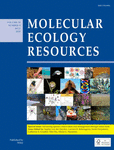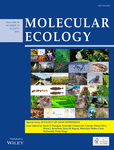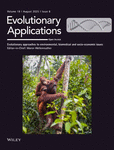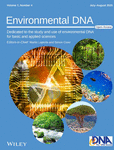Journal list menu
Export Citations
Download PDFs
ISSUE INFORMATION
Issue Information
- First Published: 06 June 2025
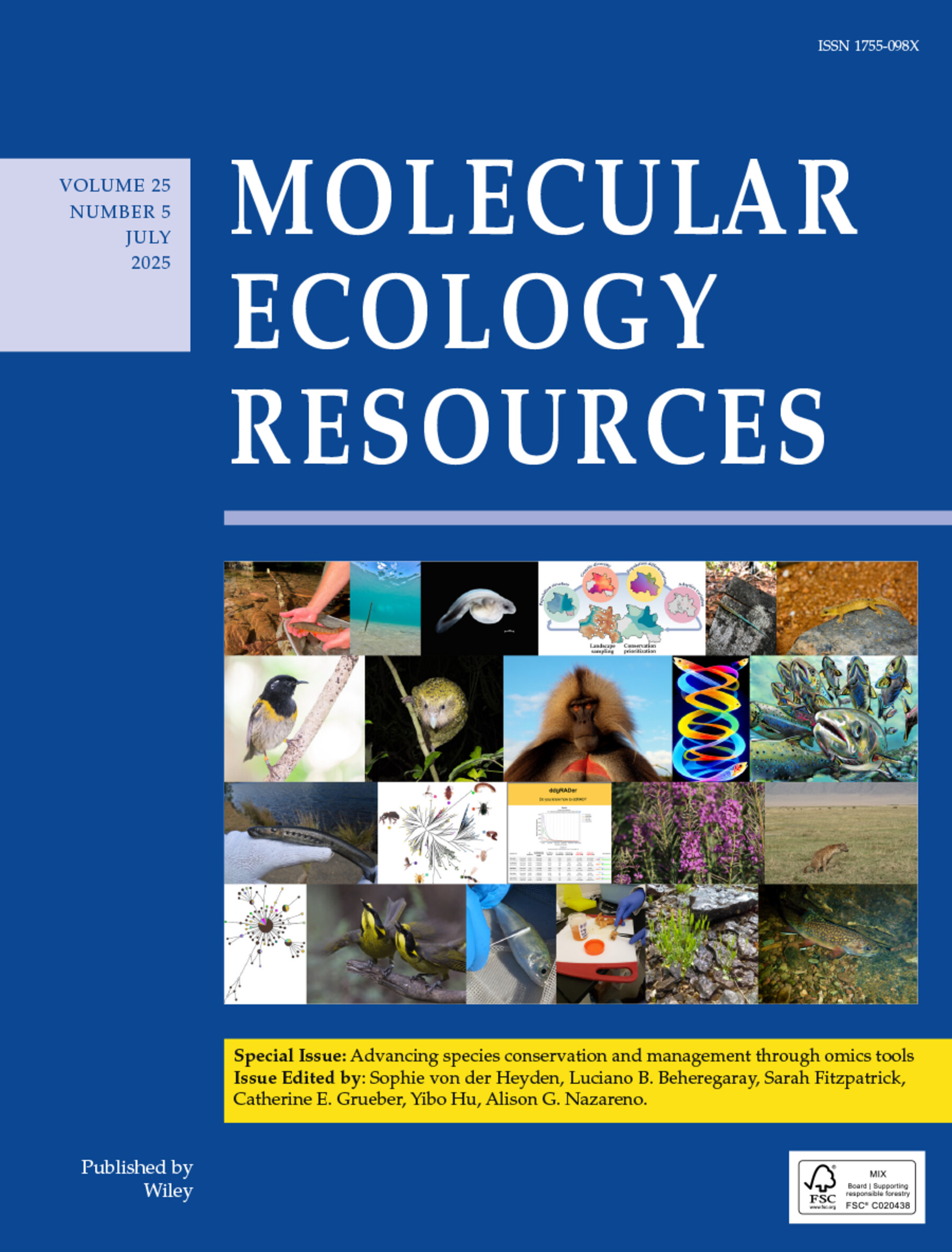
Cover Illustration: (Left to Right): (Image 1): Photo of a brook trout caught and released in the Little River located in Virginia, USA as part of a long-term genetic rescue experiment, one of the many management actions the dataset from Mamoozadeh et al. may be used to inform; (Image 2): Mangrove propagule floats in seawater; (Image 3): Scaphirhynchus sturgeon haploid gynogens only contain DNA from a maternal parent and only half of the genomic content of that maternal parent. The artificially produced haploids, malformed due to reduction in genome dosage, facilitate identification of paralogous sequence variants and true single nucleotide polymorphisms in paleotetraploid sturgeons. Photograph by Marlene Dodson, U.S. Geological Survey (Public Domain); (Image 4): Individual-based sampling and genomic-scale datasets lend greater resolution and power to landscape genomic approaches for answering important conservation questions; (Image 5): Two ‘Extinct in the Wild’ reptiles - the Christmas Island blue-tailed skink released to the wild on the Cocos-Keeling Islands, and the Lister's Gecko that still remain in the captive breeding program until such time they are also released to the wild. (Image 6): Male hihi (Notiomystis cincta), photographed on the island sanctuary of Tiritiri Matangi, Aotearoa New Zealand; (Image 7): NA; (Image 8): gelada; (Image 9): NA; (Image 10): Electronic illustration of anadromous Atlantic salmon during their upstream spawning migration; (Image 11): Adult migrating pouched lamprey (Geotria australis, kanakana/piharau) not displaying symptoms of lamprey reddening syndrome (LRS). (Image 12): Phylogenetic tree representing a diversity of invertebrates from museum collections utilising a high-throughput taxonomy-informed barcoding pipeline: Dopheide et al 2022; (Image 13): ddgRADer is a user friendly webtool for choosing restriction enzymes and size-selection criteria to optimise sequencing output of ddRADseq experiments; (Image 14): This picture shows one population of Chamerion angustifolium in the Kanas, Altay, Xinjiang, China. C. angustifolium is a mixed-ploidy species with three cytotypes: diploids, tetraploids and hexaploids, and it is widely across temperate Europe, Asia, and North America. A 100 GiB single nucleotide polymorphism genotype dataset of C. angustifolium was used in the benchmark test of VCFPOP software on a desktop computer. VCFPOP can perform a variety of population genetic analyses for haploids, diploids, autopolyploids and aneuploids, and supports a maximum ploidy level of 10; (Image 15): Spotted hyena in Ngorongoro Crater defecates. Non-invasive sampling of genetic material such as that contained in mucus covering faeces is a critical tool for population genetic studies; (Image 16): The haplotype network of fifty SARS-COV-2 genomes constructed with fastHaN; (Image 17): Sexually monomorphic species are challenging to study. Sex-linked genetic loci, which are easily identified using our R functions, can be used to sex individuals. Sex-linked loci are also important to filter out before assessing population structure, genetic diversity and parentage. Endangered helmeted honeyeaters, shown here just after mating, are sexually monomorphic, but their sex was easily assigned using our R functions; (Image 18): Minimally invasive mucus swabbing of juvenile Chinook salmon to collect DNA for SHERLOCK assay run identification; (Image 19): Dissection of largemouth bass stomach preserved in ethanol. DNA from Chinook salmon prey was extracted following dissection; (Image 20): Leavenworthia exigua in fruit in the field; (Image 21): A brook trout (Salvelinus fontinalis) swims in a cold Pennsylvania stream. Landscape transcriptomics has important implications for future management of this iconic species.
Photo Credit: (Left to Right): (Image 1): Sam Rosenbaum; (Image 2): Gustavo Maruyama Mori; (Image 3): Marlene Dodson, U.S. Geological Survey (Public Domain); (Image 4): E. Anne Chambers (illustrator); (Image 5): BTS - Parks Australia; Gecko - Jason Turl; (Image 6): Charlotte Johnson; (Image 7): Andrew Digby; (Image 8): Noah Snyder-Mackler; (Image 9): Alyssa with WOMBO; (Image 10): Caroline Côté (Image 11): Jonah Yick; (Image 12): Photos from the New Zealand Arthropod Collection provided by Darren Ward and Thomas Buckley. Phylogenetic tree compiled by Andrew Dopheide and art composition by Andrew Dopheide, Manpreet Dhami & Cissy Pan; (Image 13): Felix Glinka; (Image 14): Tongcheng Wang; (Image 15): Oliver Honer; (Image 16): Xialong Zhang; (Image 17): Merrilyn Serong; (Image 18): Melinda Baerwald; (Image 19): Wes Larson; (Image 20): Brigette Williams; (Image 21): Justin Waraniak.
EDITORIAL
Advancing Species Conservation and Management Through Omics Tools
- First Published: 06 June 2025
RESOURCE ARTICLE
Reduced representation genome approaches supporting conservation science
Sampling effect in predicting the evolutionary response of populations to climate change
- First Published: 30 June 2023
Genomic and machine learning-based screening of aquaculture-associated introgression into at-risk wild North American Atlantic salmon (Salmo salar) populations
- First Published: 28 May 2023
A new genomic resource to enable standardized surveys of SNPs across the native range of brook trout (Salvelinus fontinalis)
- First Published: 16 August 2023
Management and conservation implications of cryptic population substructure for two commercially exploited fishes (Merluccius spp.) in southern Africa
- First Published: 08 June 2023
Maintenance of genetic diversity in subdivided populations using genomic coancestry matrices
- First Published: 12 March 2023
The role of oceanic currents in the dispersal and connectivity of the mangrove Rhizophora mangle on the Southwest Atlantic region
- First Published: 12 May 2023
Haploid gynogens facilitate disomic marker development in paleotetraploid sturgeons
- First Published: 01 December 2022
Individual-based landscape genomics for conservation: An analysis pipeline
- First Published: 26 October 2023
The expansion and application of whole genome sequencing
Genomes of two Extinct-in-the-Wild reptiles from Christmas Island reveal distinct evolutionary histories and conservation insights
- First Published: 05 March 2023
Assembly of female and male hihi genomes (stitchbird; Notiomystis cincta) enables characterization of the W chromosome and resources for conservation genomics
- First Published: 18 June 2023
Massive genome investigations reveal insights of prevalent introgression for environmental adaptation and triterpene biosynthesis in Ganoderma
- First Published: 10 October 2022
High-quality genome of a pioneer mangrove Laguncularia racemosa explains its advantages for intertidal zone reforestation
- First Published: 09 September 2023
The promise and challenges of characterizing genome-wide structural variants: A case study in a critically endangered parrot
- First Published: 14 March 2023
Best practices for genotype imputation from low-coverage sequencing data in natural populations
- First Published: 21 August 2023
PoolParty2: An integrated pipeline for analysing pooled or indexed low-coverage whole-genome sequencing data to discover the genetic basis of diversity
- First Published: 03 November 2023
Epigenomic, transcriptomic, and methylome approaches
How do threatened plant species with low genetic diversity respond to environmental stress? Insights from comparative conservation epigenomics and phenotypic plasticity
- First Published: 21 November 2023
Fish species lifespan prediction from promoter cytosine-phosphate-guanine density
- First Published: 24 February 2023
Captive rearing effects on the methylome of Atlantic salmon after oceanic migration: Sex-specificity and intergenerational stability
- First Published: 09 February 2023
INVITED TECHNICAL REVIEW
Epigenomic, transcriptomic, and methylome approaches
Landscape transcriptomics as a tool for addressing global change effects across diverse species
- First Published: 01 April 2023
RESOURCE ARTICLE
Epigenomic, transcriptomic, and methylome approaches
Formalin-fixed paraffin-embedded (FFPE) samples help to investigate transcriptomic responses in wildlife disease
- First Published: 07 May 2023
Museomics and other historical approaches
Evolutionary history and seascape genomics of Harbour porpoises (Phocoena phocoena) across environmental gradients in the North Atlantic and adjacent waters
- First Published: 08 September 2023
The practice and promise of temporal genomics for measuring evolutionary responses to global change
- First Published: 24 March 2023
Fast-tracking bespoke DNA reference database generation from museum collections for biomonitoring and conservation
- First Published: 07 November 2022
Methodological advances and new analytical tools in conservation omics research
Optimizing ddRAD sequencing for population genomic studies with ddgRADer
- First Published: 21 September 2023
Evaluating restriction enzyme selection for reduced representation sequencing in conservation genomics
- First Published: 14 September 2023
vcfpop: Performing population genetics analyses for autopolyploids and aneuploids based on next-generation sequencing data sets
- First Published: 02 December 2022
Estimating resistance surfaces using gradient forest and allelic frequencies
- First Published: 27 February 2023
Scaling-up RADseq methods for large datasets of non-invasive samples: Lessons for library construction and data preprocessing
- First Published: 30 August 2023
fastHaN: a fast and scalable program for constructing haplotype network for large-sample sequences
- First Published: 26 June 2023
Easy-to-use R functions to separate reduced-representation genomic datasets into sex-linked and autosomal loci, and conduct sex assignment
- First Published: 01 August 2023
Rapid CRISPR-Cas13a genetic identification enables new opportunities for listed Chinook salmon management
- First Published: 27 February 2023
Molecular diet analysis
Toward absolute abundance for conservation applications: Estimating the number of contributors via microhaplotype genotyping of mixed-DNA samples
- First Published: 31 May 2023
Prey ration, temperature, and predator species influence digestion rates of prey DNA inferred from qPCR and metabarcoding
- First Published: 09 August 2023
The importance of curation - from samples to data
Current stewardship practices in invasion biology limit the value and secondary use of genomic data
- First Published: 30 August 2023




